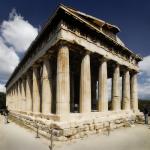|
This section contains 811 words (approx. 3 pages at 300 words per page) |

|
Anonymous, the "Critian Boy" (c. 480 B.C.E.)—The "Critian Boy" is a kouros that was dedicated on the Acropolis of Athens just before the Persian invasion of 480 B.C.E. It was damaged in the sack of Athens and buried after the Athenians recovered their city. The facial expression is sober but the "archaic smile" has disappeared, and the style of the "Critian Boy" dates it to the beginning of the early classical period. It gets its name from the resemblance of its head to the statue group of the "Tyrannicides" sculpted by Critias and Nesiotes in the decade after the Persian sack.
Anonymous, the "Zeus" from Artemisium (c. 470 B.C.E.)—This bronze statue, now in the National Museum of Greece in Athens, was found in the waters off Cape Artemisium, the northern tip of the island of...
|
This section contains 811 words (approx. 3 pages at 300 words per page) |

|



